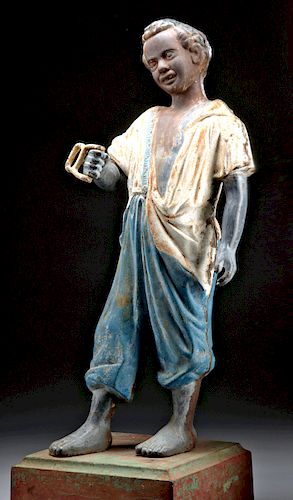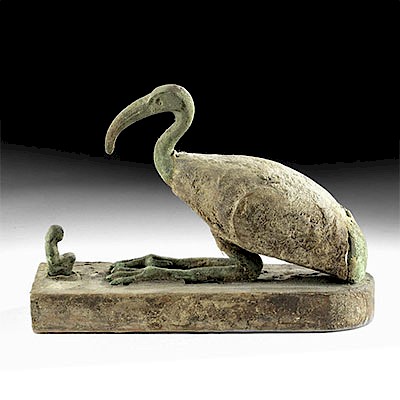18th C. American Painted Iron Hitching Post Figure
Lot 265a
About Seller
Artemis Fine Arts
686 S Taylor Ave, Ste 106
Louisville, CO 80027
United States
Selling antiquities, ancient and ethnographic art online since 1993, Artemis Gallery specializes in Classical Antiquities (Egyptian, Greek, Roman, Near Eastern), Asian, Pre-Columbian, African / Tribal / Oceanographic art. Our extensive inventory includes pottery, stone, metal, wood, glass and textil...Read more
Estimate:
$4,000 - $6,000
Absentee vs Live bid
Two ways to bid:
- Leave a max absentee bid and the platform will bid on your behalf up to your maximum bid during the live auction.
- Bid live during the auction and your bids will be submitted real-time to the auctioneer.
Bid Increments
| Price | Bid Increment |
|---|---|
| $0 | $25 |
| $300 | $50 |
| $1,000 | $100 |
| $2,000 | $250 |
| $5,000 | $500 |
| $10,000 | $1,000 |
| $20,000 | $2,500 |
| $50,000 | $5,000 |
| $100,000 | $10,000 |
| $200,000 | $20,000 |
About Auction
By Artemis Fine Arts
Oct 31, 2019
Set Reminder
2019-10-31 10:00:00
2019-10-31 10:00:00
America/New_York
Bidsquare
Bidsquare : Fine Antiquities, Asian, Ethnographic Art
https://www.bidsquare.com/auctions/artemis-gallery/fine-antiquities-asian-ethnographic-art-4581
Our Halloween Day auction features classical antiquities, ancient and ethnographic art from cultures encompassing the globe, plus fine art. Artemis Fine Arts info@artemisfinearts.com
Our Halloween Day auction features classical antiquities, ancient and ethnographic art from cultures encompassing the globe, plus fine art. Artemis Fine Arts info@artemisfinearts.com
- Lot Description
North America, Eastern United States, ca. late 18th to 19th century CE. An intriguing cast-iron lawn statue depicting a young boy of African descent standing atop an attached square iron base. The boy stands with parted legs, wears a white shirt with a deep V-shaped neck line and blue overalls, and holds a thick iron hitching buckle in his outstretched arm. The tilted head portrays large almond-shaped eyes, a bulbous nose, parted lips that reveal two rows of teeth, and puffy hair. Statues like this example - known as the "Faithful Groomsmen" - were originally created by the J.W. Fisk Company of Providence, Rhode Island in the late 18th century CE, and varying versions of the standing figures were developed in the 19th and early 20th centuries. Size: 14.75" W x 37.5" H (37.5 cm x 95.2 cm); 43.5" H (110.5 cm) on accompanying stand.
While lawn jockey hitching posts like this figure are examples of how African Americans were marginalized as slaves and property of wealthy land owners, they did not always have a negative connotation to all individuals. Slaves did use such statues for tying up horses or other animals; however, they were also 'markers' for escaped slaves on the Underground Railroad. Jockey statues like this were placed near certain crossroads or near the entrances of secret tunnels to denote the correct path to freedom, and colored ribbons were tied to the arms to indicate whether the path ahead was one of safety (denoted with green fabric) or if the escapees should keep going down the path to avoid danger (denoted with red fabric).
Another legend explains how lawn jockey statues were created as an homage to one of the young black volunteers to George Washington named Tom Graves. Tom Graves had volunteered to fight alongside General Washington during a surprise attack on encamped British forces, however Washington asked that he hold a lantern on the shoreline because he was too young to fight. During the snowy, freezing night, Washington and his men invaded the British camp after crossing the Delaware and returned victorious. Upon arriving on the shoreline, General Washington found young Tom Graves dead while standing in the snow and holding the reigns of the mens' horses. Impressed by Tom's selfless sacrifice, George Washington commissioned a dedicatory statue like this example to be placed at his estate at Mount Vernon. Nicknamed "Jocko Graves," the statues were originally designed to hold small lanterns but were eventually changed to hold reign buckles for securing horses as Tom had done in life. (For additional information, please see the article entitled "A Guide to Freedom: Jockey Statues Marked Underground Railroad" on the website for the History of Loudoun County, Virginia).
Provenance: private Glorieta, New Mexico, USA collection
All items legal to buy/sell under U.S. Statute covering cultural patrimony Code 2600, CHAPTER 14, and are guaranteed to be as described or your money back.
A Certificate of Authenticity will accompany all winning bids.
We ship worldwide and handle all shipping in-house for your convenience.
#149922Left arm reattached, with light adhesive residue along break lines. Nicks and abrasions to limbs, body, head, and original pigmentation, with encrustations and minor separation along some seams, and oxidation commensurate with age. Great earthen deposits, patina, and traces of original pigmentation throughout.Condition
- Shipping Info
-
All shipping is handled in-house for your convenience. Your invoice from Artemis Gallery will include shipping calculation instructions. If in doubt, please inquire BEFORE bidding for estimated shipping costs for individual items.
-
- Buyer's Premium



 EUR
EUR CAD
CAD AUD
AUD GBP
GBP MXN
MXN HKD
HKD CNY
CNY MYR
MYR SEK
SEK SGD
SGD CHF
CHF THB
THB














